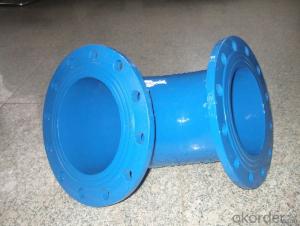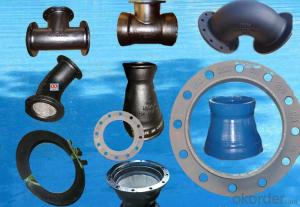Duct Iron Pipe DI Pipe ISO 2531 Double Socked 90° Bend K Type
- Loading Port:
- Tianjin
- Payment Terms:
- TT OR LC
- Min Order Qty:
- 100 m
- Supply Capability:
- 100000 m/month
OKorder Service Pledge
OKorder Financial Service
You Might Also Like
Ductile iron pipe fittings:
Dimensions standard:
ISO2531: 50-1000mm, PN10/16
BS4772: 50-1000mm, PN10/16
EN545: 50-1000mm, PN10/16
Connecting mode:
Flanged
Socketed
Mechanical connection
Loose flanged
Coatings:
Inner lined with cement and outside coated with zinc plus bitumen
Inner and outside coated with epoxy resin
Inner and outside coated with fusion bonded epoxy resin
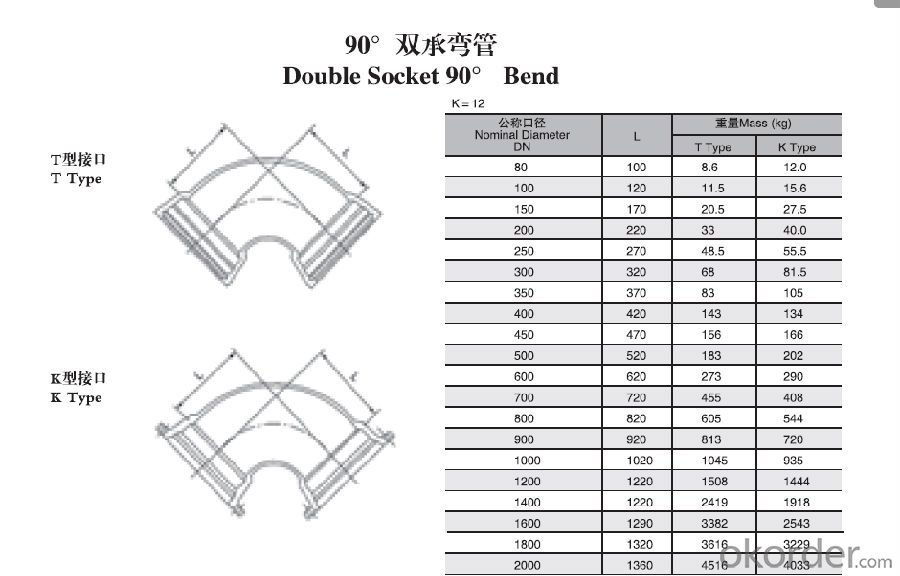
Quality:
ISO 2531 or EN 545 Standard K9 Class, K12 Class
1. ISO 9001 Certificate
2. ISO 2531 & EN 545 Certificate
3. WRAS Potable Water Certificate for FBE Internal Lining
4. WRAS EPDM Rubber Gasket or NBR Rubber Gasket
5. DN80mm - DN2000mm
6. Black Bitumen or Blue FBE / Epoxy Coating
7. Lengh = 6m or cut into 5.6m, 5.7m, 5.8m
8. Client's Brand Customization Allowable
9. Container or Bulk Loading / Shipping
10.Delivery within one Month or According to Client's Order Quantity
11. Support Client or The Third Party Inspection before Shipment
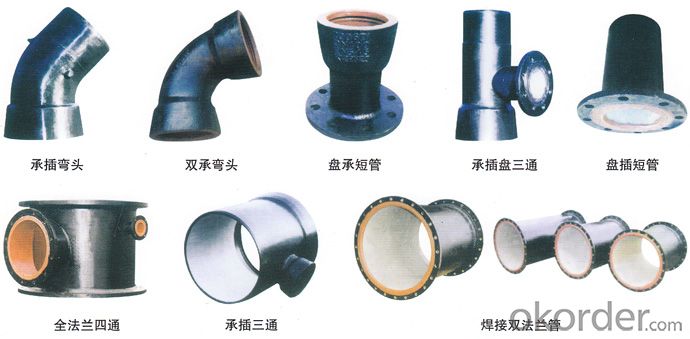
Transport:
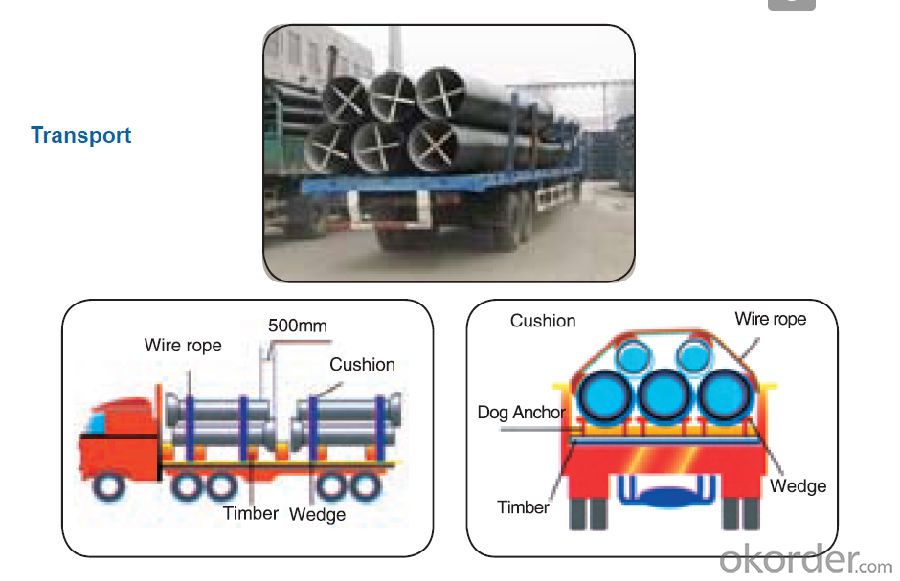
- Q:What is ductile iron?
- Ductile iron, after being treated with either magnesium or cerium, undergoes an improvement in its mechanical properties. This particular type of cast iron earns the name "ductile" due to its higher degree of ductility in comparison to other cast iron varieties. Ductility pertains to a material's capacity to stretch or deform without breaking. This quality renders ductile iron particularly ideal for applications that demand both high strength and resistance to wear and tear, such as pipes, automotive components, and machinery parts. The inclusion of magnesium or cerium during the manufacturing process aids in the formation of graphite within the iron's structure, contributing to its distinctive properties. This graphite formation serves to enhance the iron's flexibility and reduce its brittleness, enabling it to absorb shock and vibrations without fracturing. As a whole, ductile iron presents a fine balance between the strength of cast iron and the flexibility of steel, thereby establishing itself as a versatile material well-suited for diverse industrial applications.
- Q:How to control mortar proportioning in ductile iron pipe cement coating
- The mixing ratio of ductile iron pipe cement coating mortar is indicated on the design drawings, and the amount of raw material can be calculated according to mortar varieties and mixture ratio.
- Q:Is nodular cast iron pipe filled with Yau Ma Tei?
- In many areas of our country, ductile iron pipe in the middle and small diameter to tube connected with the tube, the bearing type or flange interface method; ductile iron, angle limit must be allowed better seismic performance and sealing performance.
- Q:Are ductile iron pipes suitable for water distribution networks?
- Yes, ductile iron pipes are highly suitable for water distribution networks. They possess excellent strength, durability, and corrosion resistance, making them ideal for carrying and delivering water over long distances. Additionally, their flexibility allows for easy installation and adaptability to various terrains, ensuring reliable and efficient water distribution.
- Q:QT400-10 nodular cast iron requires hardness of HRC47~51. Why can't quench hardness be reached?
- Because of the high tempering stability of the nodular iron, the tempering temperature is 400-450 degrees, and the tempering time is 1 hours.
- Q:Can ductile iron pipes be used in oil or gas transmission pipelines?
- Yes, ductile iron pipes can be used in oil or gas transmission pipelines. Ductile iron pipes have excellent strength, durability, and corrosion resistance, making them suitable for transporting oil or gas over long distances. Additionally, their flexible nature allows them to withstand ground movements and reduce the risk of fractures or leaks in the pipeline system.
- Q:What is the expected hoop stress capacity of ductile iron pipes?
- The expected hoop stress capacity of ductile iron pipes can vary depending on various factors such as the pipe's diameter, wall thickness, and material grade. However, in general, ductile iron pipes have a high level of strength and durability, making them capable of withstanding significant hoop stress. Ductile iron pipes are designed and manufactured to meet specific standards and requirements, such as the American Water Works Association (AWWA) C151 and C115 standards. These standards ensure that the pipes have sufficient strength to handle the anticipated loads and pressures they may encounter during their service life. The hoop stress capacity of ductile iron pipes is primarily determined by their tensile strength. Ductile iron is a type of cast iron that has been treated to exhibit ductility, meaning it can withstand tensile stress without fracturing. This property makes it suitable for applications where the pipes may experience internal or external pressure, such as water distribution systems or sewer lines. To determine the expected hoop stress capacity, engineers typically perform calculations based on the specific pipe dimensions, material properties, and the expected operating conditions. These calculations consider factors such as the internal pressure, external loads, and the safety factors required by the applicable design standards. It is important to note that the expected hoop stress capacity of ductile iron pipes should always be verified using the manufacturer's specifications and engineering calculations. Additionally, any modifications or repairs to the pipes should be performed by qualified professionals in accordance with industry guidelines to ensure their continued strength and performance.
- Q:The benefits of ductile iron castings
- Nodular cast iron, is a kind of high strength cast iron material developed in 50s twentieth Century, its comprehensive performance is close to the steel, it is based on its excellent performance, has been successfully used in casting complex stress, strength, toughness and wear resistance requirements of the higher parts.
- Q:Can ductile iron pipes be used for pressure reducing stations?
- Ductile iron pipes are indeed capable of being utilized in pressure reducing stations. Renowned for their robustness and resilience, these pipes are well-suited for managing applications involving high pressure. Their exceptional resistance to corrosion allows them to endure the mechanical pressures and strains typically associated with pressure reducing stations. Moreover, the smooth interior surface of ductile iron pipes minimizes friction losses and contributes to maintaining a consistent and regulated pressure within the system. Consequently, it can be concluded that ductile iron pipes are a dependable and frequently employed material in pressure reducing stations.
- Q:Can ductile iron pipes be used for water treatment plants?
- Indeed, water treatment plants are capable of utilizing ductile iron pipes. The preference for ductile iron pipes in water treatment plants stems from their exceptional qualities of endurance, robustness, and immunity to corrosion. These pipes can effectively manage water systems under immense pressure and endure the ravages of time, thereby facilitating the transportation of substantial volumes of treated water. Moreover, the extended lifespan of ductile iron pipes minimizes the necessity for frequent replacements and upkeep, rendering them an economical selection for water treatment plants.
1. Manufacturer Overview |
|
|---|---|
| Location | |
| Year Established | |
| Annual Output Value | |
| Main Markets | |
| Company Certifications | |
2. Manufacturer Certificates |
|
|---|---|
| a) Certification Name | |
| Range | |
| Reference | |
| Validity Period | |
3. Manufacturer Capability |
|
|---|---|
| a)Trade Capacity | |
| Nearest Port | |
| Export Percentage | |
| No.of Employees in Trade Department | |
| Language Spoken: | |
| b)Factory Information | |
| Factory Size: | |
| No. of Production Lines | |
| Contract Manufacturing | |
| Product Price Range | |
Send your message to us
Duct Iron Pipe DI Pipe ISO 2531 Double Socked 90° Bend K Type
- Loading Port:
- Tianjin
- Payment Terms:
- TT OR LC
- Min Order Qty:
- 100 m
- Supply Capability:
- 100000 m/month
OKorder Service Pledge
OKorder Financial Service
Similar products
New products
Hot products
Related keywords
